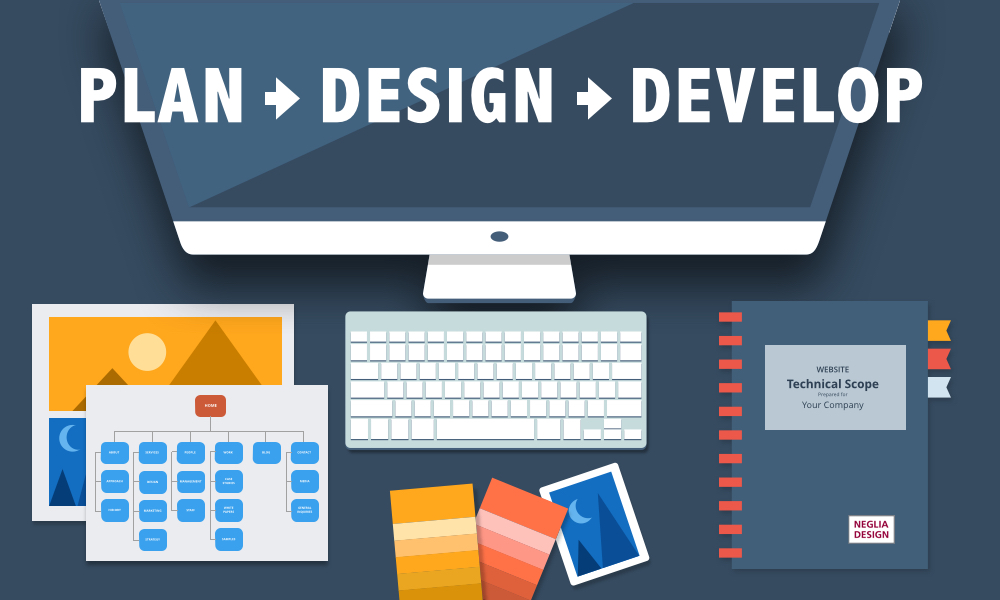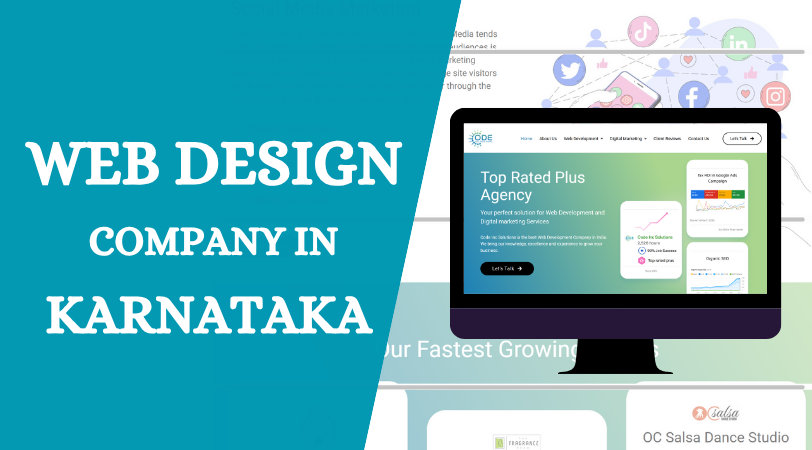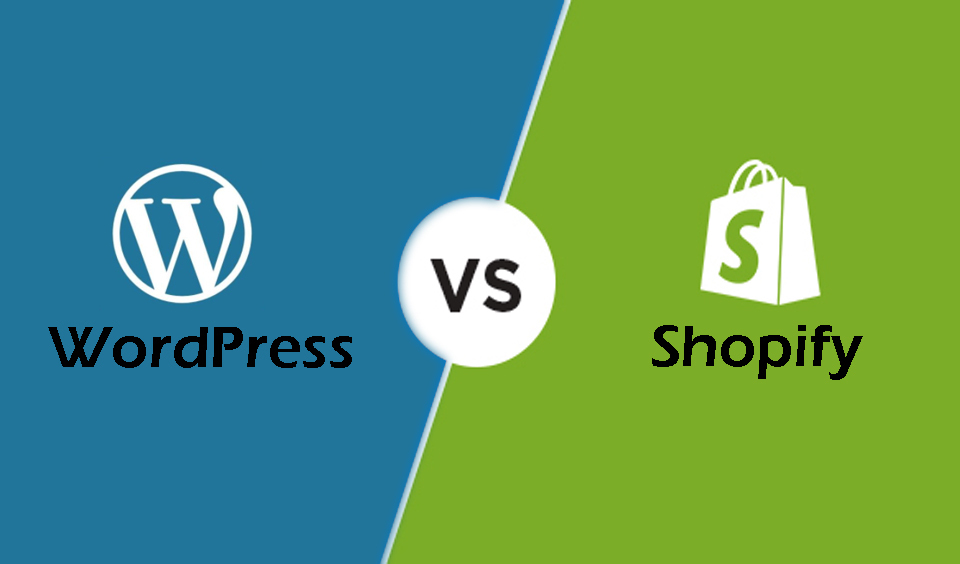A well-developed website is the bedrock of every effective online presence in the current digital era. A good website can be launched with a well-thought-out website development strategy. We will therefore discover the most critical road in the website development process and compile a flawless website development schedule.
A properly planned and smoothly running website not only draws visitors but also keeps them active, motivating them to investigate further, form well-informed opinions, and finally transform them into members or subscribers. Well-developed websites maximize search engines, improve search results power, and draw natural traffic beyond aesthetics, use, and stoner experience.
We dig into the fundamentals of Website Development in this thorough companion, including the planning stages, development process, and continuous maintenance required to create and keep an effective online presence. From formulation to implementation and maintenance, every stage helps a website succeed, therefore turning it into a critical offer or meeting digital aspirations and remaining ahead in the fierce online landscape.
Plan for website development in detail.
Creating a working and visually attractive website calls several methods of organization, production, and launch into play in website development. The process of developing a website is quite broad.
Knowing Circumstances and Developing
- Plan Compile business or consumer criteria.
- Specify the goals of the site, its target audience, and pretensions.
- Create a design plan including a financial plan, budget, and schedule.
Exploration and investigation.
- Perform competitive research and request an investigation.
- Highlightable trends, fashionable styles, and site design solutions.
Sphere Title and Hosting
- Record an internet domain name of your sphere.
- Pick a useful hosting company to house data and website files.
Wireframing and prototyping
- Create wireframes demarcating the layout and structure of the website.
- Create interactive prototypes to imagine the stoned experience.
Grounded on wireframes and prototypes
- Create the visual design.
- Design the user interface (UI), including plates, colors, and sources.
- Make sure that design rules correspond with customer experience (UX) requirements and branding guidelines.
Frontend development
- Create the architecture and layout of the website using JavaScript, CSS, and HTML code.
- Optimize for responsive design to ensure the website works well on colorful bias and screen sizes.
Rear-end Development
- Select a reasonable programming language and framework for the garcon side development.
- Cultivate the garcon, database, and operational sense needed to manage data processing and stoner relationships.
Database Architecture and Development
- Base the database structure on the requirements of the website.
- Put the database to work with relevant tools and technologies.
Integration
To guarantee perfect operation, incorporate back-end and front-end components.
- Conduct tests to discover and solve any compatibility problems.
Check the website thoroughly
- Including performance, usability, compatibility, and functionality.
- Repair and debug any bugs or imperfections created during testing.
Content population.
- Grounded on the design and structure of the website, add and enhance material (textbooks, images, video clips, etc.).
- Make sure content is relevant, accurate, and interesting for the desired followership.
Optimization
- Speed, performance, and SEO (SEO, Hunt Engine Optimization) should be optimized on the site.
- Use elegant methods to improve the stoner experience and guarantee quick loading times.
Begin
- Run one last check and test to make sure all is working as it should.
- Put the website live, Garcon, and open it to the general public.
Post-launch: conservation
- Analyze stoner comments and website performance.
- Based on stoner response and technical developments, address all concerns, update material, and advance.
I. Planning Phase: Setting the Foundation
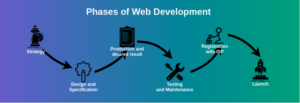
Define Objectives and Goals
- The purpose of the website must be defined.
- Measurable objectives should be determined that align with business or personal goals.
Understand the target audience.
- Do full research about your audience to know their demographics and preferences.
- Develop user personas to customize the website for different audience segments.
It is important to develop a strategy for how content is going to be created, where it will be published, and how it will be managed. Secondly, you should focus on developing an effective information architecture that would enhance both the navigation and organization of the content.
On the technology stack and tools
- Select suitable technologies and platforms according to project requirements.
- Pick tools and development frameworks for efficient development.
Budget and Resource Allocation
- Development, hosting, marketing, and maintenance budget outline.
- Human resources allocation with roles and responsibilities definition.
II. Development Phase: Bringing the Vision to Life
Design and User Experience (UX)
- Wireframes and mockups of the website layout and design need to be created.
- You should pay more attention to user experience through intuitive design, ease of navigation, and aesthetics.
- HTML, CSS, and JavaScript are used to develop the front end of a website.
- You must ensure that the site is responsive and that it can be viewed on different devices and browsers.
Back-end Development
- Develop server-side functionality, integrate databases, and apply application logic.
- Ensure security measures are implemented and performance is optimized to give end-users a great experience.
Content Implementation and SEO
- Adding and organizing website content according to the strategy defined.
- Optimizing content for search engines (SEO) to help with visibility and rankings.
III. Maintenance Phase: Keep the Website Up and Running (and Better)
Maintenance: Keeping Updated & Updates
- Enforced routine maintenance to stay current and shield the website against updates. 2. Updating features, plugins, and techs so that compatibility and efficiency are not left behind.
Security and Backup
- Needs monitoring: Secure the website regularly to eradicate possible vulnerabilities and threats from cyber attacks.
- Keep periodic backups to recover data if there is a surprise.
Performance Monitoring/Optimization
- Track website performance and page load speed continuously.
- Optimize website speed, image sizes & code to improve website performance.
Step 1: User Feedback and Analysis.
- Collect and analyze user feedback to look for room for improvement.
- Applying website analytics for the holy grail of customer action data-driven decision-making.
Summarizes the main stages of website development, i.e., planning, constructing, and maintaining, with a handy flow chart to get you started building and sustaining a successful site.
II. Planning Phase
A. Setting the Assignment of Website Development
Websites vary from project-specific goals to an organization or target audience.
Below are some typical website development goals that companies and individuals may target to achieve:
- Branding and Online Presence
- Building an experienced online profile for better branding & image.
- Maintaining the image of the brand, self, and message on their website.
Enhanced Exposure and Traffic:
- Improving search engine optimization (and thus traffic) by getting more people to search for you organically
- Implementing online marketing methods to drive specific traffic to the site.
User Engagement and Experience:
- I will create a visitor-friendly interface and inspire people to interact with my website.
- I will offer helpful, appropriate, and, most importantly, easily discoverable content to attract and cultivate users.
- Lead Generation and Conversion:
- Create powerful and clear calls-to-action (CTAs) that will help convert leads into sales.
- META: Refining landing pages and forms to drive actions from visitors.
E-commerce and Sales:
- Creating an e-commerce platform for sales and transactions on B2B Products / Services
- Simplified buying process and a safer and seamless payment process for the customers
Community & Social Interaction:
- Enabling organic conversations in an online community through forums, comment sections, or social media integrated widely—embracing formats
- Encouraging a sense of community and participating in user-generated content or discussion.
Mobile Optimization and Accessibility:
- Creating a website that is mobile-responsive and responsive to multiple devices to expand outreach.
- Meeting accessibility compliance to increase the usability of the site for people with disabilities.
Content Management and Updates:
- Develop and use the right content management system (CMS) to easily manage website content.
- Provide a content update platform so it appears fresh against what the opponent is posting.
Data Collection and Analysis:
- Analytics tools measure what is happening around users and the performance of your site.
- Data supports decisions for any improvements and optimizations.
- Scalability and future market penetration
- Create an architecture that can scale with the traffic and data required for growing the website.
- Consider future developments, functionalities, and/or feature requirements for business evolution and trends.
Creating a map and carrying out objectives within it is essential to steering the website development process as well as evaluating it. These goals need to be matched to the context or scope of the organization working ‘within’ from a broader view and how they contribute to an overall digital strategy.
A. Aim of the website
The purpose of a website is one of the most essential parts of the planning of website development. Purpose serves as the basis for the whole project, and it will lead you to its goals, content, and design.
Website Purpose and Steps to Find That
-
Know Business or Google Docs Goals:
- Begin with identifying what the purpose of this business, agency, or individual and the website is going to be controlling. These goals could be something related to the brand, revenue generation, community involvement, information sharing, etc.
-
Conduct Stakeholder Interviews:
- Conduct stakeholder interviews with business owners, marketing teams, or project managers about their expectations/requirements for the website. Tell them how they envision it, the target audience it is for, and what you want as deliverables.
-
Target Audience and User Understanding:
- You need to know who your primary and secondary audiences are for the website. Find out who he is, what they likes to do, and how… tailor the website purposefully in line with solving these demands.
-
Enumerate Core Functionalities & Features:
- List out the core functions and features (for whom and what exactly) of the website based on the required audience/target business goals. Such as e-commerce for your online store, a service-oriented website requiring a booking system, or interactive content for an information-only-based site.
-
Group Website Goals:
- Arranging and prioritizing the goals according to their importance (and relevance to the business goals). Rank the most important objectives and ensure that they can be developed well as part of your general process.
-
Take into account competitor research:
- Look at the competitor’s website to see what they are doing right, and more importantly, what is missing. This may inform you on what is required and what can make your website unique in purpose or utility.
-
Create a Strong Statement of Purpose:
- Give a statement sharing the purpose of the website briefly. It should cover the objectives (what will I do?), target audience, and expected results, e.g., “This site aims to create a simple consumer interface for online shopping tailored towards fashion geeks looking for hot apparel and accessories.”
-
Student-Validate with Stakeholders:
- Show the purpose statement to the stakeholders for their validation and feedback. Incorporate their views to validate that the purpose is in line with expectations and vision.
-
Modify to Finalize:
- Use feedback and more analysis to tweak the purpose statement so it truly reflects the goals & objectives of what the website is intended for. It needs to be exhaustive and unambiguous.
Website Development Objectives:
- Increase Website Traffic:
-
- Measurable Results—Increase organic website traffic by 30% from the previous quarter.
- Measurable—Use analytics tools (e.g., Google Analytics) to track website visitors.
- Possible: Get out SEO strategies, content marketing, and social media exposure.
- Relevant: Increasing visits is consistent with the intent of expanding the reach of the website forward.
- Time-bound: Do it within the next 6 months.
-
User Engagement User Experience:
-
- Specific: Achieve a quarter-over-quarter increase in average session duration by 20%.
- Measurable: Check session values in the analytics tools.
- Sustainable: Improve the quality of content, website speed, and UI/UX.
- Relevant: Higher time in the session means more user engagement and interest in content.
- Prioritize: Increase by the end of next quarter.
-
Increase Conversion Rate:
-
- Metrics: Convert your website’s CTR by 15% over the next six months.
- Measurable—Record the performance of sign-ups, purchases, and basically whatever you want people to do.
- Natural Disaster: Improve CTOS, user experience, and landing page
- Relevant—Higher conversion rates mean not only more revenue but also the desired user actions.
- Timed: The increase is because it has to be achieved within a 6-month timeframe.
-
Improve Mobile Responsiveness:
-
- Specific: Score 90+ on Google’s Mobile-Friendly test in 3 months.
- K picked Measurable: Use Google’s Mobile-Friendly Test to measure mobile scores.
- Can do: Make a full-blown mobile optimization and have it work easily on all devices.
- Relevant: Improved mobile responsiveness is considered to increase mobile users.
- Time-Limited: Reach the score within the next 3 months.
B. Target Audience Analysis
-
Understanding your target audience
-
- Target Audience: it is a key element in the web development process because that way you can make the website appropriate for them both (by the way that means needs, preferences, and expectations) to access.
- A holistic method to comprehend and define the target audience will be examined hereafter:
-
Conduct Market Research:
-
- Ask about your sector, market tendencies, and rivals.
- Scan Upcoming marketplace necessities and lacking areas your site might close.
-
Demographics Analysis:
-
- Find age, gender location, education level of occupation, and income range among your ideal customers.
- Keep in mind the cultural and regional implications of use — that will shape however individuals behave as customers rather than on the website interface.
-
Define Psychographics:
-
- Learn the lifestyle, values, beliefs, and behaviors of the segment you are trying to attract.
- Think in terms of motivation, dilemma, and goals that touch the goal of your website.
-
Technographic Id:
-
- E.g. Find out what devices, Browsers, and technologies most common targets have to access the internet.
- Take a peek at how much they know or are willing to use certain platforms/os/app keys
-
Behavioral Patterns:
-
- Look at your online behavior i.e. How they search, learn information, and make a buying decision and their mannerisms on websites.
- Have them fill out a brand survey and ask where they stand in social media and online communities.
-
Collect Feedback & Surveys:
-
- Provide your target audience with surveys, interviews or focus groups to harvest real insights.
-
- You can start by asking them all kinds of things from the website they expect Mr. While – Features they like and hate along with somewhat bigger issues.
-
Mine for Data
-
- With web analytics tools get basic information on the site visitors that usually visit your web pages — demographics, geography, and how they browse.
- Assess the user engagement metrics and what people like more of content-wise
-
Make User Personas:
-
- Build user personas with their specifics to your audience segments.
- Demographic, psychographic, and behavioral info with the added layer to make them feel like actual users.
-
Think User Journeys:
-
- Find that “next interaction” and Oversee the normal user journey on your website—all the different stages a visitor goes through from the get-go right up until conversion.
- It has become the default and is updated.
- Keep on stream polling your users with or without the site and feedback on inherent interactions.
- Pull from this info to refine and revise your take on the target audience and whittle down the website if needed.
Knowing who your target audience is allows designing a website that is truly recognizable by them, meets their needs, and makes room for their user-friendliness. Thus, it will make the work of the actual website, executing its goals, more effective.
2. User Personas for Websites
A very critical step in website development, drawing user personas, makes designing a website to cater to specific requirements, behaviors, and preferences of a single group easy. User personas are a little personification in some ways and stand as the generic version of all the different characteristics and traits of your target audience. Here is a walk-through to create user personas for your website:
-
Gather Research Data:
- Combine the data obtained from market research studies, surveys, interviews, analytics, etc., to learn your audience.
-
Identify Common Characteristics:
-
- Find some trends in the data to deduce common demographics, purchase patterns, goals, pain points, and more for your ideal customer.
-
Segment Your Audience:
-
- Segment your audience based on common traits and behavior patterns, and create targeting tiers. You will now have a user persona for each segment.
-
Name Your Personas:
-
- Name and even find images for your personas so they become more human-like. Select the names in a way that it sounds like the persona.
-
Generate Specific Personas:
- Create a comprehensive profile for each one of the segments.
-
Background:
- Career, background, hobbies, likes/dislikes, challenges, pain points.
-
Goals and Motive:
- What they are trying to accomplish, what their goals are by using your service.
-
Use Templates and Tools:
-
- Create user profiles (or personas) by editing templates or using online tools for the organization and delivery of information.
-
Validate Personas:
-
- Show the personas to stakeholders, team members, or target audiences for feedback and validation.
- Refine and tweak personas after getting feedback on them.
C. Content Strategy
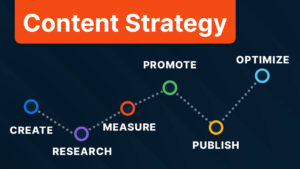
1. Website Content Types (blog post, images, video)
An important step in website development is planning (and strategizing, of course) the types of content that you will use within the website. A full content strategy for the best service of your site will ensure that the information available at your website is relevant, high-quality, and engaging to your users.
Content Type Planning: A Holistic Approach to Plan the Type of Content
-
Understand Your Audience:
-
- Think of your target audience, their preferences, tendencies, and demographics.
- So the kind of content that everyone in your audience responds best to.
-
Set Clear Objectives:
-
- Establish the objective for each type of content (Inform, Educate, Entertain, Engage, Inspire, Convert).
- Connect the content target with the wider goals of your website and company as a whole.
-
Textual Content:
-
- Blogs and Articles: Write in-depth articles that relate to your field, the products or services you offer, or themes of interest.
- Your Product/Service Descriptions: (Describe your products or services with features, benefits, and UVP.)
- Tutorials and How-To’s: Write step-by-step guides or tutorials to help your users learn what a process/product/service is.
- FAQs (Frequently Asked Questions): Tackle common questions and concerns to clarify for your audience.
- Testimonials and Reviews: Add customer testimonials & reviews to earn trust and credibility.
-
Para version visual
-
- Images: photos of high-quality brands, your product(s) services, or industry that you can use to enrich the appearance of your website
- Infographics: Break up complex information, data, or processes into easy-to-digest visual bites.
- Videos: Create informative, educational, or humorous videos for your audience and be gentle with the industry-specific ones, like video testimonials, product demos, explainer videos, or vlogs.
- Infographics—An illustrative way to show data, information, or processes with graphics simply and attractively.
-
Interactive Content:
-
- Quizzes/Polls: Offer users quizzes or polls that are based on your industry/topic of products.
- – Create online calculators related to your industry or products for value and engagement.
- Interactive Maps (Geolocation Services or Interactive/Engaging Data Visualization)
-
Audio-Related Content:
-
- Podcasting: Produce short audio episodes on industry-related trends or interviews with people that matter to your listener.
- Audio Blog—Condensing written blog posts to audio so that people who listen can still get out the latest from your industry.
-
User-Generated Content:
-
- Create an opportunity for users to contribute content like reviews, testimonials, or any creatives that have something to do with your product/service.
- Utilize curated user-generated content to support and increase perceived credibility vs. pulling all from an organic stream.
-
Consistency and Quality:
-
- Use a uniform tone, style, and brand throughout each of your content types to be perceived as an organic presence on the net.
- Ensure you’re providing content that sustains a level of value and quality to earn both trust & respect.
-
Content Calendar:
-
- Create a content calendar to strategize when the creation, publishing, or sharing of texts should be.
-
Feedback and Analysis:
-
- Collect feedback from your users and adjust content strategy per the insights.
- Use website analytics to look at how your content is performing with the data that is provided and use that to adjust your strategy and reinforce your engagement.
If you decide to plan and include a variety of content types at your disposal, it would be an ideal way to engage your crowd, communicate your brand message, and help your website get everything correct.
SEO Keyword Research as Part of Website Content Writing
You must do a good SEO (Search Engine Optimization) keyword research for the content you create; otherwise, it won’t be visible to the best searchers, and it won’t get organic traffic. An SEO keyword research guide for your website: Here are all the steps to do SEO with keywords.
-
Get to know your niche and audience:
-
-
- First, you need to know the industry/niche your website is in and the topics and interests of your target audience.
-
-
Seed your brain with some keywords:
-
- Come up with a general, broad keyword for each of the niches of your blog. These are the basics on which your keyword research should be based.
-
Use Keyword Research Tools:
- Use tools that provide intuitive keyword research as follows:
- Google Keyword Planner
- SEMrush, Ahrefs
- Moz Keyword Explorer;
- Ubersuggest
- Enter some seed keywords to get keyword ideas and an overview of search volume, competition, or trends.
-
Analyze Keyword Data
- This is the keyword suggestions review analysis of search volume and keyword difficulty.
- Keep keywords with search volume and reasonable competition as a focus.
- Long Tail Keywords to Consider
- Long-tail keywords are longer, more targeted terms that appeal to an individual group of buyers. They tend to have less competition and be highly optimized for specific searches.
- Embeds long-tail-related keywords into the content they are targeting so that your potential audience might include these words.
-
Competitor Analysis:
-
- Find what keywords your competitors are ranking for on the big KPI page (website).
- Find out the keywords your competitors are ranking for & evaluate if that is valuable enough for your website.
-
Local Keywords (if any):
-
- For location-serving websites, local traffic will be drawn in by location keywords (e.g., best restaurants in New York City).
-
User Intent:
-
- Keywords Intent (Info, transactional, navigational).
- Target their keywords to match the intent of your audience and translate to higher conversions.
-
Key Word List:
-
- Create a complete list of keywords, including expansions of the word itself, long-tail keywords, and additional phrases related.
-
Order your keywords:
-
- Break Up Your Keywords into Categories Based on Relevance and Intent This will give you an idea of your content strategy.
- Method: Keywords Integration
- Place the determined keywords in all manner of existing content of your website (meta tags, headings, title tags, URLs & image alt text).
-
Track Performance:
-
- Use SEO tools and website analytics to track the performance of keywords periodically.
- Modify the keyword strategy from performance data for better rankings and traffic. You got to the point with SEO keyword research, relevance, user intent, and both short-tail & long-tail keywords to find more traffic and positions on your website. See all our SEO services and affordable monthly SEO packages.
2: Writing sitemaps & wireframes for the website
1. Creating a Sitemap:
A sitemap creates a visual of the hierarchy of a website’s pages and how they are in a hierarchy up and down. It is the surface of a website organization and helps you to make navigation plans.
Creating a sitemap
- Example of Key Pages: Write down the important pages and sections that would be on your site right away.
- Determine Deck Order: Determine the organization of pages into a deck hierarchy, based on relevance and the way they directly relate to one another.
- Employ your diagramming tools: Use sitemap tools such as Lucidchart, draw.io, or even a pen and paper to draw your sitemap diagram.
- Make Links: Link the pages to prove how users will jump from one page to another. Illustrate the rationale with arrows.
- Final Check and Update: Check the sitemap with the project team to make sure you have all the pages and connect as needed. Revise as needed.
- Complete and Release: Complete the sitemap, produce an online version, and pass it out to development/design staff for reference.
2: Hosting options for the website
Choosing the best hosting option for your website is the single most important factor that would affect the performance, reliability, and security of your site. Some of the hosting options, features, and their use cases are as follows:
Shared Hosting:
What it does: Hosting multiple sites on a single server, resources such as CPU, RAM, and storage are shared.
- Pros:
- Cost-effective.
- Easy to set up and administer, perfect for the slack beginner.
- Cons:
- Reined resources.
- Harms the performance of other sites on the same server.
Virtual Private Server (VPS) Hosting
Introduce: A virtual server with other physical ones, on which one uses, is partitioned into several virtual servers, each with its unique hardware, such as CPUs, RAMs, and storage.
- Pros:
- More control and customization.
- Better performance than shared hosting.
- Cons:
-
- Less resource-heavy when compared to dedicated servers.
Dedicated Server:
Definition: Leasing the whole of a physical server for private use, control over resources, and configs.
- Pros:
-
- Best performance and uptime.
- Suitable for highly trafficked sites and applications.
- Cons:
- More expensive than shared or VPS hosting
- Has to be managed by someone who knows the ropes.
Website optimization for different devices:
The steps to follow. Responsive web design makes sure that your web pages can be viewed properly on a desktop computer, a tablet, or a smartphone.
-
Here’s how to achieve a mobile responsive design:
- Designing From Mobile to PC: You can start your design process from a small mobile screen and then go upwards in size. This will allow you to have a much easier and more user-friendly process.
-
CSS media queries:
- CSS media queries can help you customize different styles depending on the devices used.
-
HTML viewport meta tag:
- Use the viewport meta tag to help you control the layout.
-
Flexible layout:
- When using layouts, instead of measuring absolute pixel sizes, use percentage-based widths, ems, or rems to make sure you can still control the size of your design.
-
Responsive images:
- Always optimize images for different screen resolutions. To help, you can use the <picture> element or srcset attribute. Fluid Typography: Use viewport units to resize your fonts based on the screen size.
-
Fluid Typography:
- Typography fluidity can be accomplished with the use of relative units such as percentages, ems, or viewport units (vw, vh), making sure they scale with the different screen sizes.
-
CSS Frameworks:
- Use CSS frameworks like Bootstrap Foundation or Tailwind CSS for faster development because they come with responsive design components and grids out of the box.
-
Testing Across Devices:
- Moreover, make it a habit to routinely check your website on multiple devices and browsers as well as various screen resolutions for responsiveness and functionality.
-
Mobile Optimization:
- Enhance the mobile experience by improving anything that requires user interaction, such as buttons, links, or anything clickable, to be bigger and spaced out for easy touch interaction.
-
Conditional Loading:
- Different loading conditions will apply depending on the device’s capabilities, so try to improve performance and load times by using specific assets or content.
-
Progressive Enhancement:
- The principle of progressive enhancement in the design process is very powerful. Start with a rudimentary functioning version of the design and progressively add features for larger screens and devices.
-
Viewport Units:
- Set lengths and sizes in line with viewport dimensions by utilizing viewport units (vw, vh, vmin, and vmax) in the CSS, making it easier to scale elements accordingly.
-
CSS Flexbox and Grid:
- Create responsive designs that are fluid and adaptive to different screen sizes with modern CSS. Flexbox and Grid provide the ability to create more complex layouts with minimal effort.
Need help planning a website development strategy?
But of course, if you are planning a bigger or not-so-small project, you might want to consider hiring a professional to help you with the web development planning process, though the decision is based on numerous factors, including your level of expertise, project complexity, budget, and goals you want to achieve through your website.
Here are a few factors to weigh as you make a decision:
Expertise and Knowledge:
If you have experience in web development, project management, and a good understanding of web development processes, you may well proceed with the planning of the website development all by yourself. If you don’t have experience in web development or in-depth knowledge, bringing in some help from professionals in website development planning can be very useful.
-
Complexity of the Project:
- If it sounds like a simple, straightforward project, perhaps you could plan the website yourself; perhaps a basic website without detailed capabilities and content.
- For very complex projects that have intricate features, e-commerce capabilities, user interactions, databases, and a range of advanced functionalities, consulting with professionals is recommended for a well-structured plan.
- It might also depend on the goals and scale of the project; if you’ve placed commercial imperatives in danger or high stakes into, say, enabling revenue, great traffic, or engagement, it’s time to budget for the involvement of a professional.
- It is important here to know, should your budget constraints preclude you from hiring a dedicated professional for this planning phase, you still have options: do some in-depth online research and reach out to the web development community to find help creating a viable project plan.
-
Risk Mitigation and Quality Assurance:
- Experts have dealt with possible difficulties concerning a website’s development, bringing in a plethora of knowledge on risk management and challenge mitigation processes. Their plans allow for the inclusion of risk mitigation attempts that ensure better quality results.
-
Timeline and Efficiency:
- Working with a trained professional who is well-versed and experienced in the planning of website development expertly helps in fast-tracking the efficient use of resources and ensures that the timelines of a project are adhered to closely.
As a conclusion, even though it’s possible to independently devise a detailed work breakdown structure for a website development project, it is best to consult an expert, mainly if the project is extensive or you lack the requisite knowledge. Doing so can greatly increase the project’s effectiveness and success. Your skills, the complexity of the work, and the budget need to be considered carefully before making any decisions.

